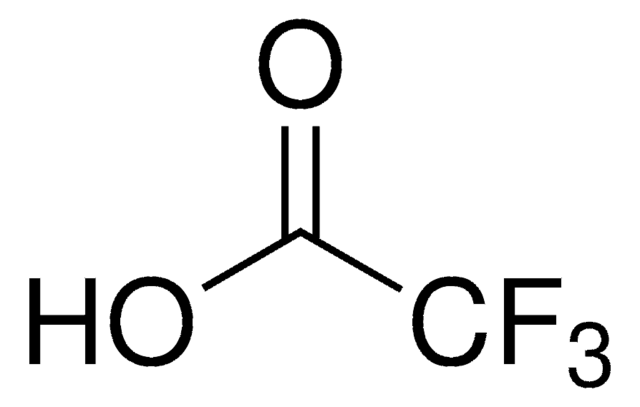1.08262
Trifluoroacetic acid
for spectroscopy Uvasol®
Synonim(y):
TFA
About This Item
Polecane produkty
gęstość pary
3.9 (vs air)
Poziom jakości
ciśnienie pary
97.5 mmHg ( 20 °C)
Próba
≥99.8% (acidimetric)
Postać
liquid
metody
UV/Vis spectroscopy: suitable
zanieczyszczenia
≤10% Water (Karl Fischer)
pozostałość po odparowaniu
≤0.005%
kolor
APHA: ≤10
przepuszczalność
265 nm, ≥10.0%
305 nm, ≥50.0%
320 nm, ≥80.0%
325 nm, ≥90.0%
współczynnik refrakcji
n20/D 1.3 (lit.)
pH
1 (10 g/L in H2O)
tw
72.4 °C (lit.)
mp
−15.4 °C (lit.)
rozpuszczalność
soluble 10 g/mL
gęstość
1.489 g/mL at 20 °C (lit.)
temp. przechowywania
2-30°C
ciąg SMILES
OC(C(F)(F)F)=O
InChI
1S/C2HF3O2/c3-2(4,5)1(6)7/h(H,6,7)
Klucz InChI
DTQVDTLACAAQTR-UHFFFAOYSA-N
Szukasz podobnych produktów? Odwiedź Przewodnik dotyczący porównywania produktów
Opis ogólny
Zastosowanie
- Characterization of ribostamycin and its impurities using a nano-quantity analyte detector: This study examines ribostamycin and its impurities using a nano-quantity analyte detector and details a systematic comparison of three different aerosol detectors. The role of trifluoroacetic acid as a mobile phase additive enhances detection sensitivity and analytical precision, making it crucial for accurate impurity profiling and pharmaceutical quality control (Meng et al., 2024).
- Paradigm Shift: Major Role of Ion-Pairing-Dependent Size Exclusion Effects in Bottom-Up Proteomics Reversed-Phase Peptide Separations: This research highlights the critical role of trifluoroacetic acid in modifying the ion-pairing and size exclusion properties of peptides during reversed-phase separations in proteomics. The study provides a deeper understanding of the mechanisms influencing peptide behavior, which is essential for developing more effective analytical techniques (Yeung et al., 2024).
- New fabric phase sorptive extraction for nondestructive analysis of heritage textile samples: This paper introduces a novel fabric phase sorptive extraction method using trifluoroacetic acid among other solvents to analyze heritage textile samples nondestructively. This method demonstrates significant potential in cultural heritage preservation and forensic science by allowing detailed analysis without damaging the original artifacts (Tanasescu et al., 2024).
- Preparation and characterization of stationary phase gradients on C8 liquid chromatography columns: The study discusses the preparation and characterization of stationary phase gradients for chromatography columns, with trifluoroacetic acid used to adjust the pH and ionic strength of the mobile phase. This modification is shown to enhance the chromatographic separation of complex mixtures, proving vital for analytical and preparative scale separations (Cecil et al., 2024).
- Optimization of Cyanocobalamin (Vitamin B(12)) Sorption onto Mesoporous Superparamagnetic Iron Oxide Nanoparticles: This investigation utilizes trifluoroacetic acid in the synthesis and functionalization of nanoparticles for efficient vitamin B(12) sorption. The study explores the implications for targeted drug delivery systems and bioseparation, demonstrating the adaptability and effectiveness of these engineered nanoparticles (Flieger et al., 2024).
Komentarz do analizy
Water (K. F.): ≤ 0.10 %
Colour number (Apha): ≤ 10
Evaporation residue: ≤ 0.005 %
UV-transmission (at 265 nm): ≥ 10.0 %
UV-transmission (at 305 nm): ≥ 50.0 %
UV-transmission (at 320 nm): ≥ 80.0 %
UV-transmission (from 325 nm): ≥ 90.0 %
Inne uwagi
Informacje prawne
produkt powiązany
Hasło ostrzegawcze
Danger
Zwroty wskazujące rodzaj zagrożenia
Zwroty wskazujące środki ostrożności
Klasyfikacja zagrożeń
Acute Tox. 4 Inhalation - Aquatic Chronic 3 - Eye Dam. 1 - Skin Corr. 1A
Kod klasy składowania
8A - Combustible, corrosive hazardous materials
Klasa zagrożenia wodnego (WGK)
WGK 2
Temperatura zapłonu (°F)
212.0 °F - Pensky-Martens closed cup
Temperatura zapłonu (°C)
> 100 °C - Pensky-Martens closed cup
Certyfikaty analizy (CoA)
Poszukaj Certyfikaty analizy (CoA), wpisując numer partii/serii produktów. Numery serii i partii można znaleźć na etykiecie produktu po słowach „seria” lub „partia”.
Masz już ten produkt?
Dokumenty związane z niedawno zakupionymi produktami zostały zamieszczone w Bibliotece dokumentów.
Klienci oglądali również te produkty
Produkty
Being one of the most popular flavors, we present a HPLC fingerprint method and vanilla extract reference materials to help distinguish natural from synthetic or adulterated vanilla.
Protokoły
Straightforward HPTLC-MS analysis of lactose in dairy products (milk or yoghurt) using only protein crash, centrifugation and dilution as sample preparation.
Aripiprazole is an atypical antipsychotic and a partial dopamine agonist. It is primarily used in the treatment of schizophrenia, bipolar disorder, major depressive disorder, tic disorders, and irritability associated with autism. Aripiprazole was first approved by the U.S. Food and DrugAdministration in November 2002 for schizophrenia and by the European Medicines Agency in June 2004 for acute manic and mixed episodes associated with bipolar disorder.
Catalyst screening, KitAlysis™ High-Throughput Screening Kits, Thin layer chromatography (TLC), parallel analysis, parallel synthesisigh-Throughput Buchwald-Hartwig Amination Reaction Screening Kit, TLC-MS analysis
Nasz zespół naukowców ma doświadczenie we wszystkich obszarach badań, w tym w naukach przyrodniczych, materiałoznawstwie, syntezie chemicznej, chromatografii, analityce i wielu innych dziedzinach.
Skontaktuj się z zespołem ds. pomocy technicznej






